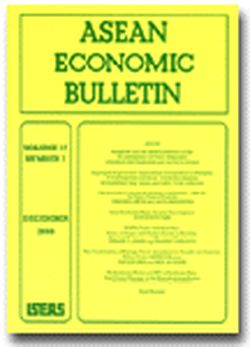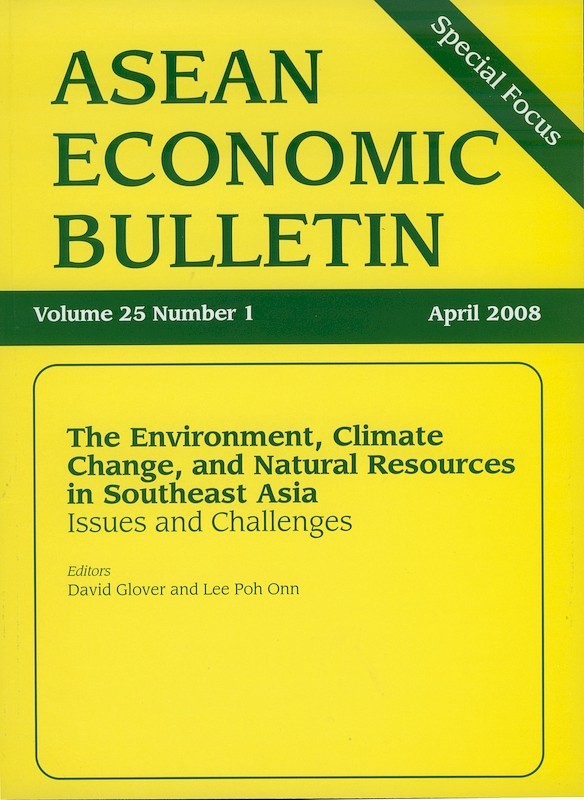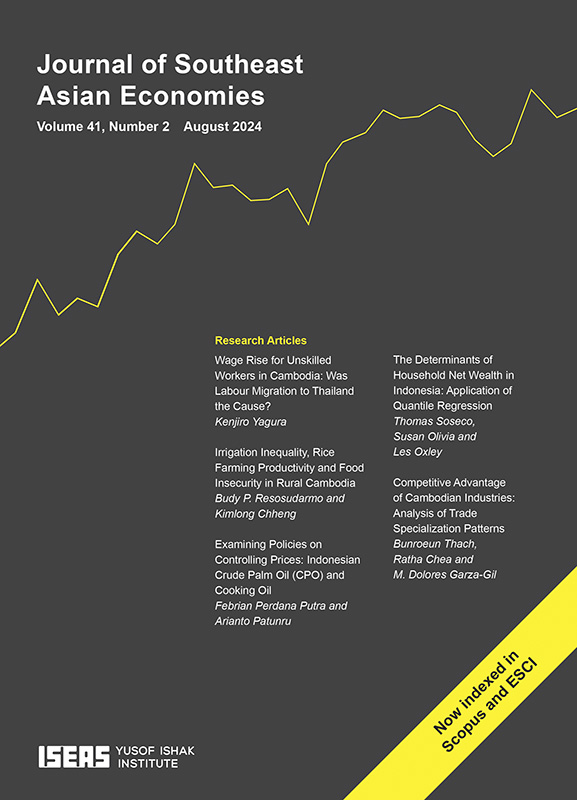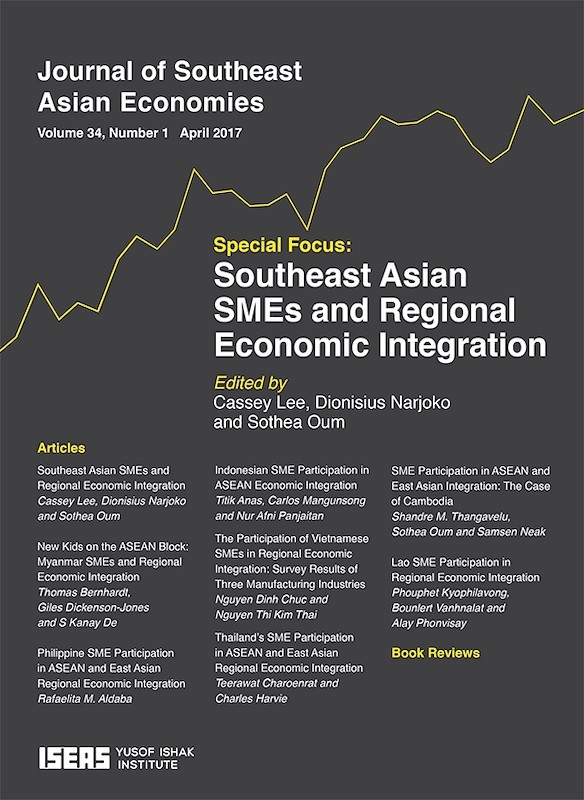Journal of Southeast Asian Economies Vol. 38/1 (April 2021)

Date of publication:
April 2021
Publisher:
ISEAS – Yusof Ishak Institute
Number of pages:
160
Code:
AE38/1
About the publication
Contents
-
Journal of Southeast Asian Economies Vol. 38/1 (April 2021)
[Whole Publication, ISSN: 23395206] -
Preliminary pages
- RESEARCH ARTICLES
-
1. Tax Reform and Demands for Accountability in the Philippines, by Gabriella R Montinola, Matthew S Winters, Masaru Kohno, Ronald Holmes, authors see abstractIn January 2018, soon after he was elected President of the Philippines, Rodrigo Duterte signed a comprehensive tax reform bill. In this paper, a nationwide survey and embedded experiment are used to investigate how ordinary Filipino citizens responded to different possible changes in tax incidence originating in the reform. The survey was conducted a few days prior to the enactment of the legislation. Our survey experiment yielded two noteworthy findings. First, Filipino citizens’ interest in gathering information about the government budget and its usage increased when they were explicitly reminded of the possibility that the reform would change their tax burden; importantly, this occurred whether they expected their taxes to increase or decrease. Second, lower class citizens were more motivated than upper class citizens to monitor government when faced with the prospect of major tax burden changes. These findings not only shed light on how ordinary citizens in the Philippines reacted to the impending historic tax reform, but also reveal limits of the conventional fiscal contract conception of the link between taxation and accountability.
-
2. Does Competition Enhance or Hinder Innovation? Evidence from Philippine Small and Medium-Sized Enterprises, by Tristan Canare, Jamil Paolo Francisco, authors see abstractCompetition has two possible contrasting effects on firm innovation. On one hand, it can force businesses to innovate to become more competitive. On the other, competition can shrink a firm’s market share, revenues and profit, making it difficult to implement costly innovations. Applying logistic regression on data from a survey of 480 small and medium-sized enterprises (SMEs) in the Philippines, this paper found evidence that there is a generally positive relationship between competition and innovation. The magnitude of the relationship, however, depends on the type of innovation. The form of innovation most strongly associated with competition is improvement in the production process, followed by improvement in marketing. It is most weakly associated with introduction of a product new to the market and with improvement of an existing product. There is also some evidence that the magnitude of the competition-innovation relationship varies across sectors and across firms of different sizes.
-
3. An Investigation of the Interrelations among Macroeconomic Variables in Thailand under Inflation-Targeting for the Post-Financial Crisis Period, by Akhand Akhtar Hossain, Popkarn Arwatchanakarn, authors see abstractThis paper employs a five-variable monetary policy transmission model within a structural vector error correction (SVEC) modelling framework for Thailand to examine the relative contributions of the policy interest rate and a monetary aggregate of real output and prices. The model is estimated using quarterly data for the 2000Q2–2019Q4 period after imposing both short- and long-term restrictions. The empirical results suggest that the policy interest rate and the monetary aggregate contribute significantly to the forecast-error-variances of real output and prices, irrespective of whether the policy interest rate or the monetary aggregate appears to be the lead variable. That a shock to the money stock contributes to real output and to prices, whether treated as a policy instrument or as an endogenously determined variable within a generalized macroeconomic system, is consistent with the implication of classical monetary theory, which suggests the existence of a long-run equilibrium relation among money, real output, prices, interest rates and exchange rates. The results also support a co-integral relation among the four variables in Thailand. A major policy implication is that an inflation-targeting central bank such as the Bank of Thailand can deploy a monetary aggregate as a monetary policy instrument, particularly in a low inflation environment.
-
4. Intergovernmental Transfers in Indonesia: The Risk Sharing Effect of Dana Alokasi Umum, by Junichiro Takahata, Teguh Dartanto, Khoirunurrofik Khoirunurrofik, authors see abstractGiven that most local governments in Indonesia depend heavily on intergovernmental transfers, this study tries to examine whether <i>Dana Alokasi Umum</i> (DAU, or general allocation fund) is able to absorb a revenue shock from the fluctuation of <i>Pendapatan Asli Daerah</i> (PAD, or local government revenue). The results suggest that DAU does, in fact, absorb around 83 per cent of the revenue shock. This share is greater than the compensation rate determined by the allocation formula employed in the Indonesian intergovernmental transfers system set annually by the Directorate General of Fiscal Balance, Ministry of Finance. Once the differences among local government levels are considered, it is found that DAU covers PAD decrease across all levels of local government throughout the country, but the extent of coverage depends on a number of criteria.
- RESEARCH NOTES
-
5. Growth Slowdowns and Stagnation: in the Middle The Middle-Income Trap Revisited, by Raveen Ekanayake, author see abstractThis study first reframes the “middle-income trap” paradigm as the incidence of growth slowdowns and stagnation in the middle. This is followed by an analysis of its determinants using a cross-country panel data covering sixty-five middle-income countries between 1997 and 2017. The findings suggest that, as economies approach the “Lewis turning point”, low value-added labour-intensive economic activities become less and less competitive, setting the stage for moving into a skill- and capital-intensive growth phase. To successfully navigate the middle-income transition, countries must look beyond capital accumulation, invest in developing human capital capabilities to sustain international competitiveness in the face of rising wage pressures, and induce structural change in favour of high value-added economic activities.
-
6. Assessing the Impact of the Regional Comprehensive Economic Partnership on ASEAN Trade, by Sithanonxay Suvannaphakdy, author see abstractThe Regional Comprehensive Economic Partnership (RCEP) is a regionwide free trade agreement (FTA) linking the ten ASEAN economies to their “+5” partners, namely Australia, China, Japan, New Zealand and South Korea. It covers both trade and non-trade related issues ranging from rules of origin and trade facilitation to intellectual property rights and investment. This study examines the likely impact of RCEP on trade alone, taking into account the fact that all its members are already participants in a number of other FTAs. Using latest FTA data from the WTO on imports and exports, this study reveals that tariff reduction under RCEP will erode ASEAN’s trade preferences provided by existing FTA partners, while reallocating import sources of ASEAN countries towards more efficient RCEP partners.
- BOOK REVIEWS
-
BOOK REVIEW: Asia’s Journey to Prosperity: Policy, Market and Technology over 50 Years, by Peter McCawley, author
-
BOOK REVIEW: Automotive Industrialisation: Industrial Policy and Development in Southeast Asia, by Kaoru Natsuda and John Thoburn, by Tham Siew Yean, author
-
BOOK REVIEW: The ASEAN Way: Sustaining Growth and Stability, edited by Ana Corbacho and Shanaka J. Peiris, by Cassey Lee, author
-
Thank You List






